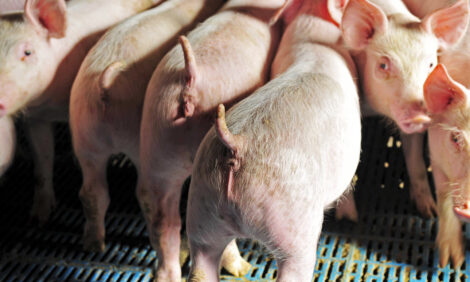



Danish Pig Sector Delivering Improvements in Welfare
DENMARK - The Danish pig meat sector is forging ahead with measures to improve the welfare of pigs and also the eating quality and consumer image of the sector.
The advances being made following the Pig Welfare Summit in last year 2014 are published in the latest progress report from the Danish Pig Research Centre.
Last year’s meeting was called by the Danish Minister of Food, Agriculture and Fisheries, Dan Jørgensen, and signatories to the agreement included representatives from the Danish Pig Research Centre (now part of SEGES), leading consumer and animal welfare organisations, the veterinary profession and Danish retailers.
The agreement included the setting of a number goals to ensure a continuing improvement in welfare standards on Danish pig farms.
Amongst these are the improvement of survival rates of piglets, finding alternatives to the castration of male piglets to avoid the risk of boar taint, reducing the occurrence of stomach ulcers, moving towards the loose-housing of sows throughout the whole production cycle and eliminating tail-docking.
“We are pleased to announce that our industry has already made significant progress in meeting the commitments we made at last year’s ‘Pig Welfare Summit,” said Erik Larsen, Chairman of the Danish Pig Research Centre.
“We recently launched a new information campaign, called ‘Pattegriseliv’, to help ensure that our farmers implement best practice to enhance piglet survival rates and our pioneering work in developing new systems for ‘freedom farrowing’ has already attracted major interest internationally.
“Our research to find alternative strategies to limit the risk of ‘boar taint’ continues apace – including feed and breeding trials, as well as investigating new selection protocols on our slaughter lines.
“We have also implemented a number of research projects which we hope will lead to new strategies for addressing the risk of outbreaks of tail-biting among our pigs”.
The monitoring and advances on piglet survival have shown that 50 per cent of herds are expected to wean at least one pig more per year sow and that this level is expected to be maintained for six months.
From 2008 to 2014, mortality fell from 15 per cent to 11.9 per cent of year sows. The target is to achieve below nine per cent before 2018.
The research has revealed new insights regarding underweight piglets' energy and information has been shared with farrowing experts and incorporated into daily advice.
In the research to discover ways of reducing boar taint without castration, the first sows have been inseminated with semen from Duroc boars selected bon breeding value for boar taint.
The skatole content in fat is a good indicator of presence of boar taint, while androstenone has varying importance for sensory quality.
Boar taint and taste also found in the very lean cuts. The research centre said that there is a need for further research into the options for the use of meat from entire male pigs.
The second phase of the study into reducing the numbers of tail-docked pigs is underway, where a comparison is being made to measure the extent of tail-biting in groups of pigs where tails have been half-docked and where no tail-docking has been carried out.
The preliminary results show that there is a greater prevalence of tail biting in groups of non-tail docked pigs.
There are significant differences in the extent of tail-biting in different production units and between trial herds.
The research centre is also looking at different pens to reduce tail biting and Concept pens and accompanying control pens are being set up. The prevalence of tail biting is expected to be lower in the concept pens.
The researchers are also looking at support tools to reduce tail biting and a trial herd has been found. Sensory equipment to be set up. If an early warning system can be developed, more producers will be prepared to abolish tail docking.
The progress report was published as around 400 delegates meet this week at a major conference in Copenhagen to review the latest developments in improving pig welfare internationally.
The conference is entitled ‘Improving pig welfare – what are the ways forward?’ and is being hosted by the Danish Ministry of Food, Agriculture & Fisheries.
“We are looking forward to meeting with colleagues from around the world at this week’s conference. I feel it will be an excellent opportunity for Danish farmers to showcase much of the work we are doing to build on what we have already achieved and ensure the delivery of even better pig welfare standards in future,” added Mr Larsen.








